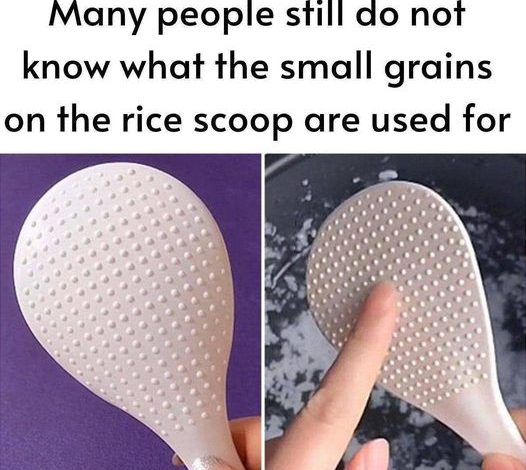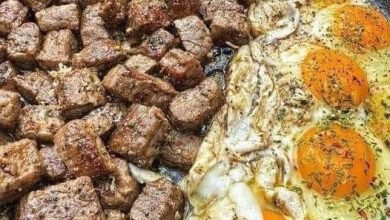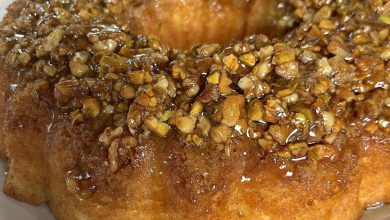
ADVERTISEMENT
The Secret Behind the Dimpled Rice Scoop: An Ingenious Design for Perfect Rice
ADVERTISEMENT
Introduction
For many people, cooking rice is a daily ritual, yet it’s often accompanied by a surprising struggle to serve it perfectly. Enter the rice scoop, a staple utensil found in kitchens around the world, particularly in households where rice is a diet essential. You may have noticed the tiny “grains” or dimples on the surface of a typical rice scoop but never given them much thought. What purpose do they serve? These small bumps are, in fact, a clever design feature with a specific purpose: to make handling sticky rice easier. Here’s everything you need to know about the humble, dimpled rice scoop and why it’s a must-have tool in the kitchen.
1. The Challenge of Serving Sticky Rice
Rice, especially short-grain varieties like sushi rice, tends to be sticky when cooked, making it difficult to serve without clumping. Traditional rice utensils without any texture often lead to frustration, as the rice sticks to the surface, making it hard to scoop neatly and cleanly.
In many cultures where rice is a staple, serving it without creating a mess is important not just for appearance but also as a point of pride in presentation. For example, in Japanese and Korean households, perfectly formed scoops of rice are a standard, whether serving plain rice or forming rice balls. The sticking issue called for an innovative solution, and that’s where the textured rice scoop comes in.
ADVERTISEMENT
2. How the Dimpled Surface Works
The small bumps or “grains” on a rice scoop are specifically designed to reduce the surface area that the rice can stick to. This texture creates tiny air pockets between the rice and the scoop, which help prevent suction, making it easier for rice to release from the scoop with minimal resistance.
Here’s how it works:
- Minimizes Surface Contact: The dimples mean that only a small fraction of the rice touches the scoop’s surface at any given time, which reduces the stickiness that occurs when rice grains make direct contact with a smooth surface.
- Creates Air Pockets: The tiny spaces formed by the dimples allow for air circulation, which keeps the rice from creating a vacuum effect on the scoop. This is especially helpful with sticky rice, as it allows each scoop to slide off more easily.
- Easy Release: Thanks to these design features, the rice doesn’t clump as heavily on the scoop, allowing for easier and cleaner serving. You can create smooth scoops or form rice balls with less hassle, and your scoop stays much cleaner than it would without this textured surface.
3. Additional Benefits of a Textured Rice Scoop
Apart from preventing stickiness, the dimpled rice scoop offers several other practical benefits:
ADVERTISEMENT
- Easier Cleaning: Because the rice doesn’t cling as stubbornly, cleaning a dimpled rice scoop is faster and easier. Residual rice falls off more easily under running water, which means less time spent scrubbing.
- Efficient Serving: With less rice clinging to the scoop, you can serve rice more efficiently, without having to stop and scrape it off constantly. This is especially helpful when serving multiple people, as you can serve clean scoops with each dip.
- Improved Rice Texture: When scooping and shaping rice, a textured scoop helps retain the natural texture of each grain, especially for dishes where presentation matters. It allows for smooth, rounded servings without compressing the grains too much.
4. Choosing the Right Rice Scoop for Your Kitchen
Not all rice scoops are created equal, and if you’re in the market for one, it’s good to consider these features:
- Material: Rice scoops are typically made from plastic, bamboo, or stainless steel. Plastic is lightweight and easy to clean, while bamboo is eco-friendly and traditional. Stainless steel scoops are durable, but rice may still cling more easily than on textured plastic or bamboo surfaces.
- Size and Shape: Look for a scoop that feels comfortable in your hand and has a rounded shape for better handling. Some rice scoops are designed with ergonomic handles to provide extra grip and control.
- Texture Quality: High-quality rice scoops have well-defined dimples that work effectively to prevent sticking. Some may also come with a non-stick coating, but the dimples alone are usually effective.
- Heat Resistance: If you’re using a plastic scoop, ensure it is heat-resistant to avoid any risk of melting or warping when scooping hot rice directly from the cooker.
5. More Kitchen Tools with Textured Surfaces
The rice scoop isn’t the only kitchen tool that uses texture to solve a sticky problem. Here are a few other utensils that take advantage of similar designs:
- Non-Stick Spatulas: Many spatulas come with small ridges or a non-stick coating that prevents food from sticking, making them ideal for flipping pancakes, eggs, and other foods that tend to cling.
- Pastry Brushes: The bristles on pastry brushes are designed to hold liquids without dripping, similar to how a dimpled scoop holds rice without it sticking.
- Mesh Strainers: Some strainers come with fine meshes and textured surfaces to prevent foods like rice or pasta from clumping together while draining.
These designs all work on the same principle: reduce surface contact or create small air pockets that prevent food from sticking, making cooking and serving easier.
ADVERTISEMENT
6. Making the Most of Your Rice Scoop
While a rice scoop may seem like a single-use tool, it can actually be quite versatile. Here are some tips for making the most of this utensil:
- Use for Sticky Foods: The dimpled surface of a rice scoop also works well with other sticky foods like mashed potatoes, sticky desserts, and some pasta dishes, helping you serve these foods more easily.
- Forming Rice Balls and Sushi: For those who enjoy Japanese cuisine, the rice scoop is ideal for shaping onigiri (rice balls) and preparing sushi. The dimpled surface prevents the rice from compacting too much, which keeps the rice fluffy and easy to shape.
- Portioning: Rice scoops can be helpful for portion control. By using the same scoop size for each serving, you can ensure consistent portions for each person at the table.
Conclusion
The rice scoop, with its humble dimpled design, is a perfect example of functional, thoughtful engineering in the kitchen. By understanding the purpose of the small grains or bumps on its surface, we can appreciate the clever design that makes scooping rice a simpler and less sticky task. For anyone who prepares rice regularly, the dimpled rice scoop is a game-changer, transforming the way we serve and enjoy one of the world’s most beloved staple foods.
This small but mighty kitchen tool serves as a reminder that sometimes, the simplest designs can have the biggest impact on our cooking experience. So, next time you scoop rice, take a moment to appreciate the humble dimpled scoop—and the ingenious design that makes enjoying a perfect serving of rice just a little easier.




